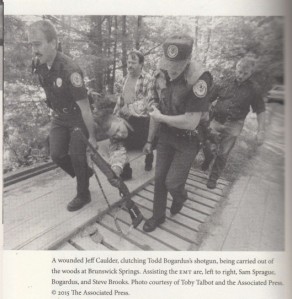In the Evil Day: Violence Comes to One Small Town by Richard Adams Carey
19 August is the anniversary of the attack on Colebrook, NH.

This isn’t really a book review. Nor is it a reminiscence. I’ve written more extensively elsewhere on the Colebook massacre; the attack on my town by by an assault-weapon wielding man that left four dead and many more wounded. Including personal friends of mine: Scott Philips went to my church; Dennis’ Joos’ wife was a fan of my books.
As Mr. Carey points out, memories vary. They shift over time. My memory varies in some points from what he’s written. That’s fine. There are a hundred– a thousand– different memories. But, having said that, I have two bones to pick with this book.
First, while Mr. Carey does an excellent job of identifying all of the law enforcement officers shown in the photos and such, he does not identify any of the EMTs. Observe the caption on the photo: “A wounded Jeff Caulder, clutching Todd Bogardus’s shotgun, being carried out of the woods at Brunswick Springs. Assisting the EMT are, left to right, Sam Sprague, Bogardus, and Steve Brooks. Photo courtesy of Toby Talbot, and the Associated Press.” How hard would it have been to identify “the EMT” as Dave Fuller of the Stratford Ambulance Corps? Law Enforcement wasn’t t he only public safety group affected. In the years after the event, in the emergency medicine community, marriages broke up, ex-smokers took up smoking again, others dropped out or moved away. The trauma spread out.
he only public safety group affected. In the years after the event, in the emergency medicine community, marriages broke up, ex-smokers took up smoking again, others dropped out or moved away. The trauma spread out.
Second, no matter how good one’s storytelling instincts, you can’t put the inner thoughts of a man who was dead by the end of the day, who never wrote his thoughts down or spoke with another person, into a work of non-fiction. “Imaginative license,” Mr. Carey writes, “has been exercised in describing Carl Drega’s thoughts, memories, and state of mind as he climbed out of his Dodge pickup in the parking lot of LaPerle’s IGA and as he prepared to destroy his home and flee into Vermont. The rendering of such episodes from Drega’s point of view represents my best educated guess, as a storyteller, in the portrayal of moments that must ultimately remain inscrutable.” If you add fiction to non-fiction, the result is fiction. It adds doubt to a narrative that needs to have sharp lines. It adds a question mark to the inner thoughts of others among the dead that are also recounted here, even though it’s entirely plausible that they might have spoken to somebody, told the person at the next desk, mentioned to a friend, what they’d been thinking that day. Also, I disagree with Mr. Carey as to what Mr. Drega’s thoughts, memories, and state of mind may have been, and my storytelling ability is pretty darned good.
The book needs an index.
All this being said: I learned things I hadn’t known, including that “In the fall of that same year [2002], in Nashua, [Vin] Suprynowicz would be the guest of honor, the featured speaker at the thirtieth annual convention of the New Hampshire Libertarian Party.” People who want to know why I will never vote for any Libertarian, for any reason, at any time, in any race, even if no one else is running, need look no further. As I said elsewhere, “I spit in your face, Vin Suprynowicz. You aren’t fit to speak the names of the heroes your boy shot down.”
This isn’t a long book, 311 pages, but it took me over a month to read it. I had to stop fairly often.
I recommend it to everyone.
